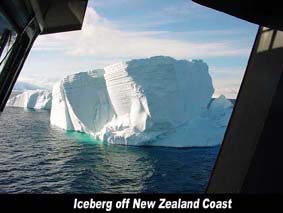Icebergs are large floating chunks of ice. In order to float, they need to displace a volume of water that is equal in weight. Submarines use this principle to rise and sink in the water by changing their weight.

But the rising sea temperature and these huge ice blocks play a role in the rising ocean level. These chunks of frozen glaciers break off from the face of glaciers and ice shelfs and fall into the ocean. The rising temperature are causing more to form by weakening the glaciers, causing more cracks and making ice more likely to break off. As soon as the ice falls into the ocean, the ocean rises a little.
Generally, these frozen blocks inhabit the ploar regions, although several were recently seen in New Zealand waters for the first time in 56 years. The last time one was visible from the New Zealand shore was June 1931. The largest measured about 1.8 km (1.1 miles) in length and stood some 120 meters (360 feet) above water. The bergs were likely to be part of a larger piece of ice which broke off the Ronne Ice Shelf, located southeast of the Falkland Islands, six years ago. The original chunk of ice, named A-43, was 167 km (104 miles) long 32 km (20 miles) wide.
Scientists are being careful not to attribute these bergs to climate change as it is a natural, but rare phenomenon. However, a marked warming trend is evident in the Antarctic Peninsula, with spectacular loss of ice shelves,and movement of glaciers which must cause a rethink, and link to global warming.

See Also
